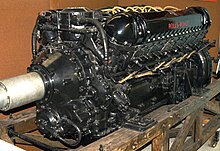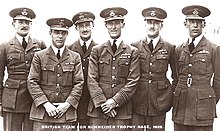Rolls-Royce R
Shortly after the 1931 competition, an R engine using a special fuel blend powered the winning Supermarine S.6B aircraft to a new airspeed record of over 400 miles per hour (640 km/h).
[2] An official British Government contract to proceed with the project was not awarded until February 1929, leaving Rolls-Royce six months to develop the engine before the planned Schneider Trophy competition of that year.
[3][4][nb 2] The R was a physically imposing engine designed by a team led by Ernest Hives and including Cyril Lovesey, Arthur Rowledge and Henry Royce.
[8] To make the R as compact as possible, several design modifications were made in comparison to the Buzzard: the propeller reduction gear housing was reshaped, and the camshaft and rocker covers were modified to fair into the shape of the aircraft's nose, the air intake was positioned in the vee of the engine (which also helped to avoid the ingress of spray), and beneath the engine the auxiliaries were raised a little to reduce the depth of the fuselage.
[7] The introduction of articulated connecting rods was regarded as a "nuisance" by Arthur Rubbra, a Rolls-Royce engine designer, as there were inherent problems with the arrangement.
Articulated rods were used in the Goshawk engine, but were not embodied in the later Rolls-Royce Merlin, for which Arthur Rowledge had designed a revised blade and fork system.
Traditional cooling methods using honeycomb-type radiators were known to cause high drag in flight; consequently it was decided to use the surface skins of the S.6 wings and floats as heat exchangers, employing a double-skinned structure through which the coolant could circulate.
However, even with this system in use, engine overheating was noted during the race flights, requiring the pilots to reduce the throttle setting to maintain a safe operating temperature.
[13] A not-so-obvious cooling measure was the deliberate use of a rich fuel mixture, which accounts for the frequent reports of black smoke seen issuing from the engine exhaust stubs.
The double-sided supercharger impeller was a new development for Rolls-Royce: running at a ratio of almost 8:1, it could supply intake air at up to 18 pounds per square inch (psi) (1.24 bar) above atmospheric pressure, a figure known as "boost" and commonly abbreviated as "+x lb".
[19] It was discovered that adding 10% methanol to this mixture resulted in a 20 hp (15 kW) increase, with the further advantage of reduced fuel weight – particularly important for aircraft use – due to its lowered specific gravity.
[20][nb 4] The engine was further tested and cleared for limited sprint racing at 2,783 hp (2,075 kW) at 3,400 rpm and +21 lb (1.45 bar) of boost,[21] but this capability was not used due to concerns with the S.6B's airframe not being able to withstand the power, and the inability of the aircraft to lift the extra fuel required to meet the increased consumption.
Eight men were required to run a test cell, led by the "Chief Tester" who had the tasks of logging the figures and directing the other operators.
One of these chief testers was Victor Halliwell who later lost his life whilst on board the water speed record contender Miss England II.
[22] Development time was short and the deafening sound of three Kestrels and an R engine running at high power for 24 hours a day took its toll on the local population.
The Mayor of Derby stepped in and asked that the people endure the noise for the sake of British prestige; subsequently testing continued for seven months.
The majority of this was spat out of the exhaust ports and smothered the test cell walls, milk being given to staff to minimise the effects of this well-known laxative.
[22] Overseen by Cyril Lovesey, flight testing commenced on 4 August 1929 in the new Supermarine S.6 at RAF Calshot, a seaplane and flying boat station on Southampton Water in Hampshire.
Technological advances used in the R engine, such as sodium-cooled valves and spark plugs able to operate under high boost pressures, were incorporated into the Rolls-Royce Merlin design.
[33] The author Steve Holter sums up the design of the Rolls-Royce R with these words:[34] Quite simply the R-type engine was far ahead of its time, a marvel of British skill and ability.The Schneider Trophy was a prestigious annual prize competition for seaplanes that was first held in 1913.
[41] The Italian and French entrants however, failed to ready their aircraft and crews in time for the competition,[42] and the remaining British team set both a new world speed record at 379 mph (610 km/h) and, unopposed, won the trophy outright with a third consecutive victory.
[43] The original Trophy is on display in the London Science Museum along with the S.6B that secured it, as well as the R engine that powered this aircraft for the subsequent airspeed record flight.
[45] Immediately after the 1929 Schneider Trophy contest Squadron Leader Augustus Orlebar, commanding officer of the High Speed Flight, set a new airspeed record of 355.8 mph (572.6 km/h) using Supermarine S.6, N247.
[46] On 29 September 1931, barely two weeks after the British team had secured the Schneider Trophy outright, Flight Lieutenant George Stainforth broke the world airspeed record in a Rolls-Royce R-powered Supermarine S.6B, serial S1595, reaching an average speed of 407.5 mph (655.67 km/h).
At Sir Malcolm's knighthood ceremony in February 1931, King George V expressed great interest in the R and asked many questions about its fuel consumption and performance.
[51] Two R engines, R17 and R19, were built for Sir Henry Segrave's twin-engined water speed record boat Miss England II, this craft being ready for trials on Windermere by June 1930.
On Friday 13 June, Segrave was fatally injured and a Rolls-Royce technical advisor, Victor Halliwell, was killed when Miss England II capsized at high speed after possibly hitting a log.
[58][59] On 18 July 1932, Kaye Don set a new world water speed record of 119.81 mph (192.82 km/h) on Loch Lomond in a new boat, Miss England III, which also used engines R17 and R19.
Villa learnt his trade of "aircraft mechanic" in the Royal Flying Corps; his first job was fitting Beardmore 160 hp engines to airframes.
In his notes Leo Villa refers to an R18 engine, but according to Holter this may have been R17 converted to clockwise rotation at the request of Malcolm Campbell rather than an additional example.











